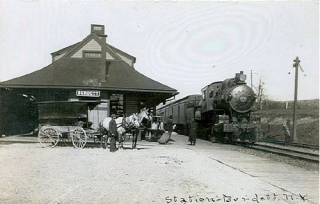History of the Town of Hector

Virgin forests were rapidly cleared making way for farming. Streams and waterfalls gave birth to a variety of mills that encouraged the growth of population centers attracting general stores, tradesmen, schools, churches and post offices. By 1820 the recorded population of Hector over 4,012 made it the most populated of all towns in then Tompkins County. In 1854 the Town of Hector with a population of 5,500 became part of the newly created Schuyler County.
A north-south ridge, “Hector’s backbone,” divides the township. Western Hector, with a lake-moderated climate, supports a fruit farming area and has become famous for its vineyards, wineries and distilleries. Seneca Lakes’ navigable waters linked to the New York State canal system and enabled farmers to connect with distant markets. By the late 1800’s, the main line of the Lehigh Valley Railroad offered faster transportation, two of Lehigh’s gorge spanning railroad trestles including the “twin tunnels” north of Burdett and the magnificent cut-stone arch near Valois which can still be seen today.
While railroads never expanded into eastern Hector because of the hilly terrain, the 200-mile Catskill Turnpike and the well traveled Newtown Road passed through eastern Hector. Along their stretches, the landscape was dotted with taverns and stage stops. Local self-sufficient farmers marketed grains, hay, chickens, cattle and hogs creating a local economy that supported the streamside mills, general stores, blacksmiths and harness shops.
During the prosperous late 1800’s, original log homes were replaced by gracious homes, typically built in the Greek Revival and Federal styles. By 1870, the importance of religious life in Hector was evident. 18 churches served Baptists, Methodists, Episcopalians and Presbyterians. Perry City had the only Friends Meeting House in the county. Camp meetings were held along the lake shore near Valois. Farm families joined one of the several granges which provided social interaction.
Hector’s population began decreasing during the times of post Civil War depression that coincided with the opening of the west. By 1930, during the Great Depression, only 2,904 people were living along the dirt roads in this still rural area.
Several measures to counter the effects of the Great Depression had lasting impact on the Town of Hector. The 1935 Rural Electrification Bill which brought electricity to rural areas did not have a significant impact until the late 1940’s when most hamlets and outlying areas had electricity. In the early 1930’s, the land comprising the Hector Land Utilization Area (HLUA) was purchased in connection with the Federal Agricultural Adjustment program by authority of the National Industrial Recovery Act of 1933, and the Emergency Relief Act of 1935. In 1935 the HLUA was turned over to the Resettlement Program, and acquired lands in Hector on a willing seller/willing buyer basis and then turned them over to the US Soil Conservation Service for appropriate stewardship. Almost a half-century later these lands became part of the multiple use Finger Lakes National Forest The Forest continues to work with the Hector Grazing Association which has been in existence since 1946, to maintain or improve range conditions and provide habitat for grassland dependent plants and animals.
During the last half of the 20th century, many parts of Hector were being transformed into “bedroom communities.” Central schools replaced the little schoolhouses at crossroads and the only remaining general store was in the Hamlet of Hector. At the turn of the 21st century, Hector retains much of its natural beauty. The remaining farms continue to create the “rural atmosphere” that both residents and tourists find attractive.

